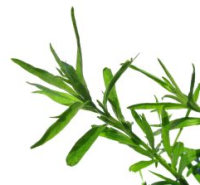Tarragon Characteristics
(Artemisia Dracunculus)

Name Origin:
It’s name means dragon and it was once thought to be an effective treatment against that creature’s bites. More on the History of Tarragon.
Natural Order:
Compositæ
Growing Cycle:
Hardy, Shrubby Perennial
Origins:
Tarragon, believed to be a native of southern Russia, Siberia and Tartary has been cultivated for around 600 years.
Height:
3 – 6 feet tall
Characteristics:
Numerous branching stems with lance-shaped leaves that are highly aromatic.
Tarragon Flowers:
White, somewhat greenish, globular and sterile.
Before Growing Tarragon:
Be cautious of any seeds labeled tarragon. They are usually not real tarragon or Artemisia Dracunculus. They are a related plant this is similar in appearance but they does not have the desirable flavor of real tarragon. Tagetes lucida may be used as a tarragon substitute and is easily propagated by seeds but does have a weaker flavor.
Growing Tarragon
(cultivation, propagation and harvest)
Tarragon Cultivation.
Tarragon plants prefer dry, rather poor soil in a warm location. In cold climates both the plant and surrounding soil should be protected from multiple freezing and thawing cycles. For the best results, plants should be replaced every four years.
Tarragon Propagation.
Tarragon is only propagated by cuttings, layers and divisions. Plant in loose soil.
Maintain spacing of 18-24 inches apart once the plants grow to 15-18 inches tall.
Harvesting Tarragon.
For dried tarragon, gather leaves in midsummer. A second cutting may be made in late September or early October.
Tarragon Companion Planting Guide
Growing tarragon with eggplant offers benefits for the eggplant plants. In fact, companion planting tarragon with just about anything in the garden is beneficial since the scent of tarragon is disliked by most pests. Tarragon is thought to be a nurse plant which means it will enhance the growth and flavor of anything planted nearby.
Tarragon Uses
(shoots and young leaves, tarragon oil, and tarragon vinegar)
Tender Shoots and Young Leaves.
Tarragon is used in a wide variety of dishes. It is often used in salads and with steaks and chops and is frequently found in French cooking. Pickles, stews, soups, croquettes, and other meat dishes are also often flavored with tarragon. It is also a favorite flavoring for fish sauces.
Tarragon Oil.
Tarragon oil comes from the greens of the plant and has been used for hundreds of years to perfume toilet articles. One pound of tarragon essential oil can be obtained from 300 to 500 pounds of plant.
Tarragon Vinegar.
Tarragon vinegar is where this herb really shines. Gather tarragon greens in the morning and wash. Put in jars covered with a high-quality vinegar for a few days. Use your tarragon vinegar as desired.